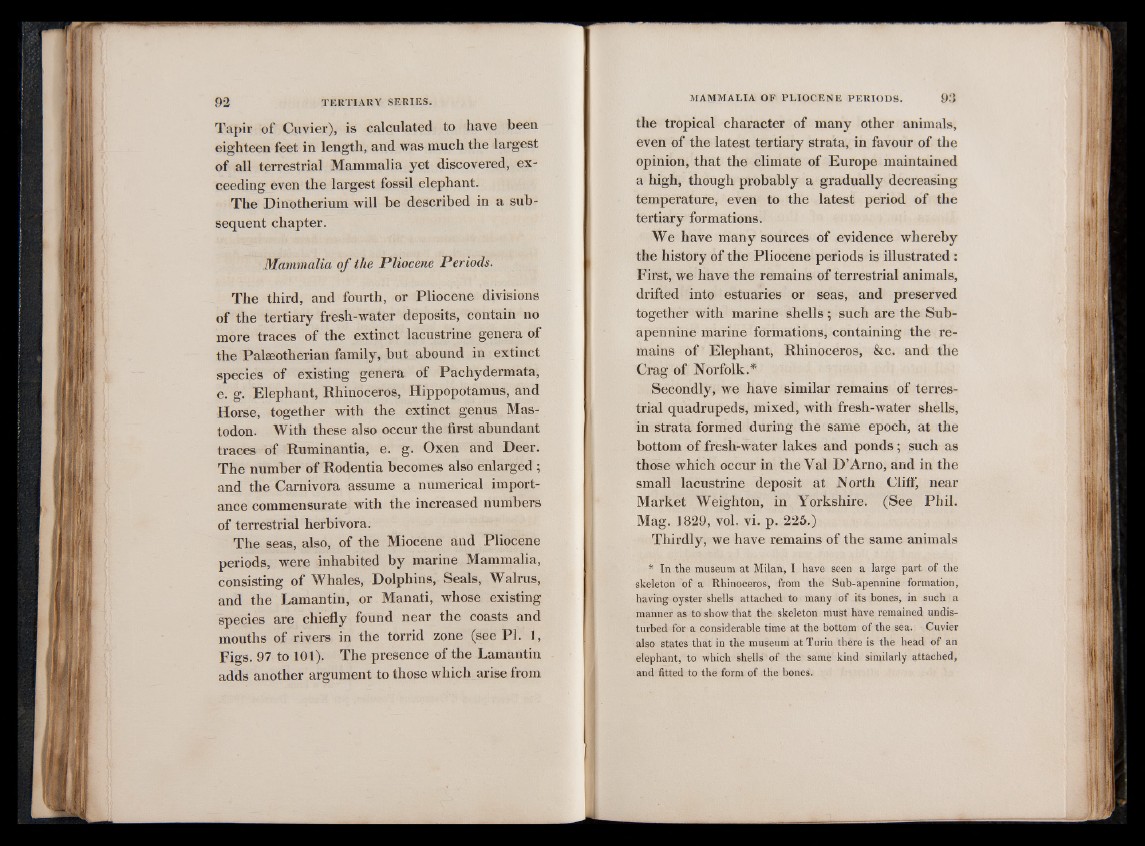
Tapir of Cuvier), is calculated to have been
eighteen feet in length, and was much the largest
of all terrestrial Mammalia yet discovered, exceeding
even the largest fossil elephant.
The Dinotherium will be described in a subsequent
chapter.
Mammalia o f the Pliocene Periods.
The third, and fourth, or Pliocene divisions
of the tertiary fresh-water deposits, contain no
more traces of the extinct lacustrine genera of
the Palaeotherian family, but abound in extinct
species of existing genera of Pachydermata,
e. g. Elephant, Rhinoceros, Hippopotamus, and
Horse, together with the extinct genus Mastodon.
With these also occur the first abundant
traces of Ruminantia, e. g. Oxen and Deer.
The number of Rodentia becomes also enlarged ;
and the Carnivora assume a numerical importance
commensurate with the increased numbers
of terrestrial herbivora.
The seas, also, of the Miocene and Pliocene
periods, were inhabited by marine Mammalia,
consisting of Whales, Dolphins, Seals, Walrus,
and the Lamantin, or Manati, whose existing
species are chiefly found near the coasts and
mouths of rivers in the torrid zone (see PI. 1 ,
Figs. 9 7 to 10 1 ). The presence of the Lamantin
adds another argument to those which arise from
the tropical character of many other animals,
even of the latest tertiary strata, in favour of the
opinion, that the climate of Europe maintained
a high, though probably a gradually decreasing
temperature, even to the latest period of the
tertiary formations.
We have many sources of evidence whereby
the history of the Pliocene periods is illustrated :
First, we have the remains of terrestrial animals,
drifted into estuaries or seas, and preserved
together with marine shells; such are the Sub-
apennine marine formations, containing the remains
of Elephant, Rhinoceros, &c. and the
Crag of Norfolk.*
Secondly, we have similar remains of terrestrial
quadrupeds, mixed, with fresh-water shells,
in strata formed during the same epoch, at the
bottom of fresh-water lakes and ponds; such as
those which occur in the Val D ’Arno, and in the
small lacustrine deposit at North Cliff, near
Market Weigh ton, in Yorkshire. (See Phil.
Mag. 1829, vol. vi. p. 225.)
Thirdly, we have remains of the same animals
* In the museum at Milan, I have seen a large part of the
skeleton of a Rhinoceros, from the Sub-apennine formation,
having oyster shells attached to many of its bones, in such a
manner as to show that the skeleton must have remained undisturbed
for a considerable time at the bottom of the sea. Cuvier
also states that in the museum at Turin there is the head of an
elephant, to which shells of the same kind similarly attached,
and fitted to the form of the bones.